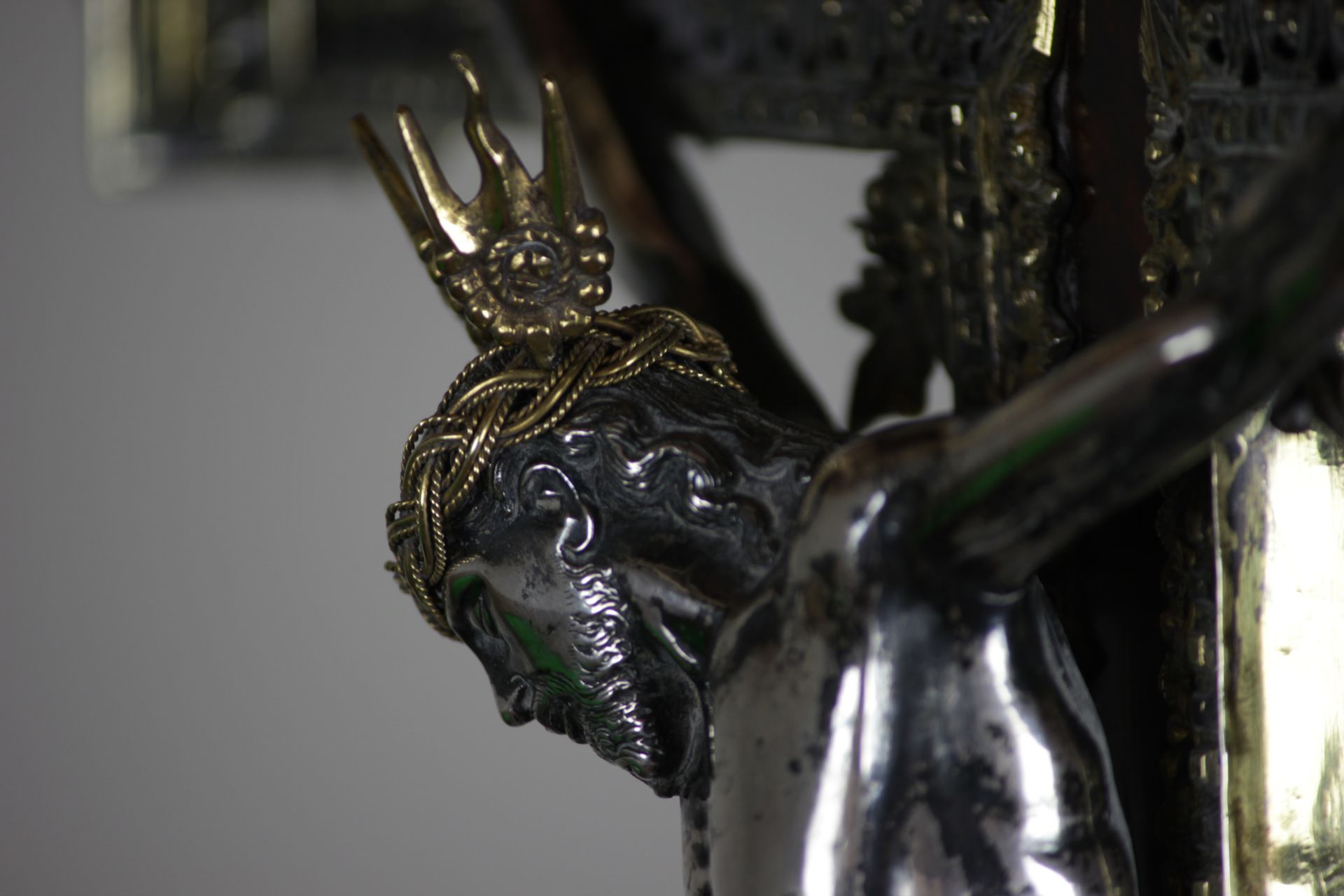Crucifix from the Workshop of Guglielmo della Porta, circa 1570-1600
Price on request
Workshop of Guglielmo della Porta, an exceedingly fine and rare 16th century Crucifix, circa 1570-1600
The exceptional craftsmanship of this remarkable Crucifix is characterised by its exquisitely carved details. The smallest elements of Christ's appearance, such as his hair curls, beard, open mouth, heavy eyelids, furrowed brow, veins, sinews, musculature, knuckles, joints, fingernails, toenails, the flowing folds of his perizonium (loincloth) and twisted 18 karat gold crown of thorns are rendered with the highest level of skill and quality.
In this depiction of Cristo Morto (dead Christ), the beautifully proportioned body is unmarked, conveying the idea that Jesus' suffering was not only physical but also spiritual, as he took on the sins of humanity. The crucifixion is portrayed with intense agony and exhaustion, evoking feelings of compassion, gratitude, and awe in the viewer. The Saviour hangs from a gilded silver and tortoiseshell inlaid cross, with a titulus inscribed in Latin, ‘Iesvs Nazarenvs Rex Ivdeorvm’ (Jesus of Nazareth, the King of the Jews) placed above him. At the base of the cross, a silver skull is positioned, symbolising the place where Jesus was crucified, referred to as "Golgotha" or the "place of the skull". This skull is also known as the "Calvary skull" or "Golgotha skull."
Guglielmo della Porta was a prominent sculptor, architect, and silversmith of the late Renaissance or Mannerist period in Italy. Born to a family of skilled masons, sculptors, and architects, della Porta received his initial artistic training in his uncle's workshop in Genoa, where he worked on the Cathedral of Milan and was assigned the task of sculpting and reinterpreting the works of Leonardo da Vinci until around 1530. He refined his skills under the tutelage of the painter Perin del Vaga, working on notable projects like the Villa del Principe and the Palazzo di Andrea Doria.
In 1537, della Porta relocated to Rome, where he was greatly influenced by the works of Michelangelo. Della Porta quickly established himself as a talented sculptor and received many commissions from important patrons, including Pope Julius III and the Farnese family. He worked on a number of notable projects, including the design of the tomb of Pope Paul III in St. Peter’s Basilica, the decoration of the Farnese Palace in Rome, and providing the legs for the Farnese Hercules when it was first excavated. Even when the original legs were found years later, Michelangelo recommended that della Porta's legs be retained as they demonstrated how modern artists were capable of creating works comparable to those of the Ancients.
Della Porta was a skilled silversmith and created several notable works in silver, including a masterpiece of Baroque silverwork, the silver crucifix he completed for the Church of Santa Maria degli Angeli. Della Porta's skill as a sculptor is evident in the lifelike and expressive features of the figure, which is rendered in silver with intricate detailing and texturing.
Guglielmo della Porta’s workshop was proficient in the production of crucifixes by 1569 and possibly as early as 1560 when della Porta turned his concentration toward religious subjects rather than classical ones, notable by Alessandro Farnese’s request for “crucifixes made of solid silver and other gilt metals” for St. Peter’s Basilica in 1569. The quantity of crucifixes in various stages of production left at the time of Guglielmo’s death in 1577 is another indication of the demand for his crucifixes. His posthumous inventory counts at least 58 examples, finished and unfinished and ranging in size from approximately 20 to 70 cm.
Two notable assistants of della Porta that had a particularly active role in completing crucifixes on behalf of Guglielmo are Antonio Gentili da Faenza (ca. 1519–1609) and Sebastiano Torrigiani (d. 1596). In 1570, Gentili was entrusted to execute twelve reliquary busts for Pope Pius V (1504-72) using Guglielmo’s designs. Torrigiani cast the same Gentili-treated crucifix featured on the Farnese altar cross for an altar cross he produced for Pope Gregory XIII (1502-85) in 1583, also donated to St. Peter’s Basilica, where it is today displayed in the same room as Gentili’s altar service for Alessandro Farnese.
During the Renaissance period, it was common for rulers and nobles to exchange gifts as a sign of diplomatic or personal relations. In 1572, Pope Gregory XIII sent a silver crucifix as a gift to the Spanish king, Philip II, as a symbol of their strong alliance. Similarly, in 1580, the Duke of Savoy sent a silver crucifix to Pope Gregory XIII as a gift, which is now held in the Vatican Museum. The gilt bronze relief of Mount Calvary at El Escorial, attributed to della Porta, was a gift to Bianca Capello Granduchess of Tuscany from Pope Gregory XIII in 1580.
This magnificent Crucifix stands as a testament to the exceptional skill and artistry of the Renaissance period and is a powerful representation of the Christian faith that has inspired viewers for centuries.
Provenance; private collection, Spain.
Measurements of the cross; 49cm long and 38cm wide.
Measurements of the Corpus Christi; 21cm long and 19.5cm wide.
Related and comparative literature:
Reconstituting a Crucifix by Guglielmo della Porta and his colleagues, 2017, M. Riddick.
Madrid, Coll and Cortes, Guglielmo della Porta. A Counter-Reformation Sculptor, 2012, R. Coppel, C. Avery and M. Estella.














